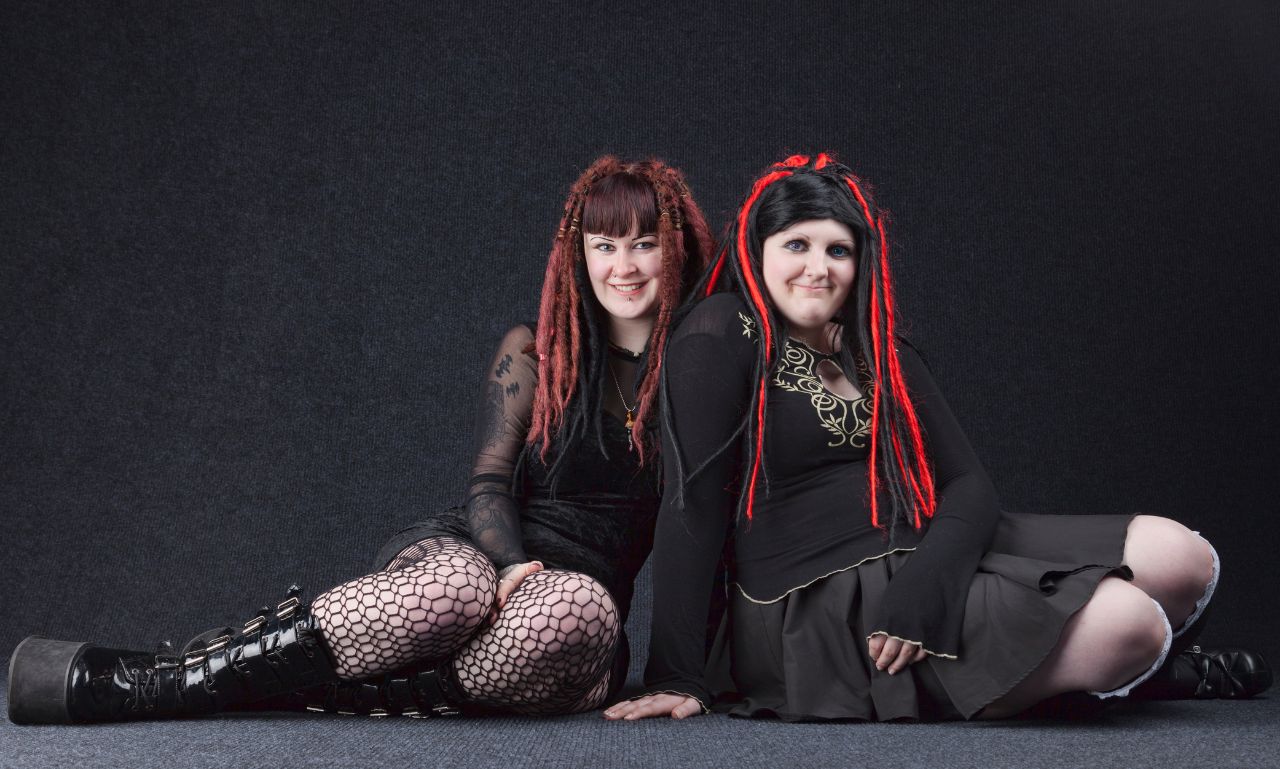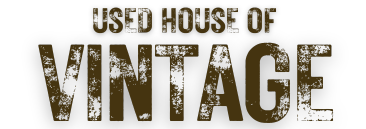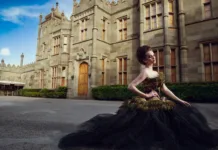Last Updated on August 24, 2023 by Used House Of Vintage
When it comes to clothing, vintage is always in. And for good reason, too. Vintage items often have a unique style that can’t be found anywhere else. Vintage Goth clothing is all about creating a dark, moody look that will make you stand out from the crowd. Whether you’re going for a classic goth look or something more experimental, these pieces will help you get the look you want.
Vintage Goth clothes have been around for many years now, and there is a good reason why they are so popular. Vintage Goth clothes are often associated with an era that was full of creativity and experimentation, and they can be worn to any formal or informal event. If you’re looking to add a bit of history and glamour to your wardrobe, then check out the vintage Goth clothes available online today!
The Emergence of the Goth Style
The vintage Goth scene is one that has been around for quite some time, and it has a pretty rich history. While the roots of the Goth subculture may be traced back to the late 1960s and early 1970s, the vintage Goth scene really took off in the 1980s. This was largely due to the release of music by bands like The Cure, Bauhaus, and Siouxsie and the Banshees, which helped to cement the style as a popular form of fashion. Today, vintage clothes remain a popular choice for those who want to dress in something stylish and unique.
Gothic fashion is a term used to describe clothing and other items with a dark, dramatic style and atmosphere – in particular, clothing designed for someone who engages in a goth subculture. Find out how goth fashion developed over the years and why so many people are eager today toward the old-fashioned popularity of this style.
The History of Vintage Goth Clothes

There is no one definitive answer to the question of when vintage Goth clothing first started appearing on the scene. However, there are a few likely candidates. One possible explanation is that the style may have originated among the goths who congregated in nightclubs in the late 1970s and early 1980s. In those days, Goths often dressed in dark, morbidly glamorous clothing and makeup, which may have inspired others to adopt similar styles.
Another possibility is that vintage Goth clothes may have been popularized by musicians like Marilyn Manson and Danzig in the late 1980s and early 1990s. At that time, many people who were interested in Gothic music began to dress similarly. In fact, some people argue that it was Manson’s look – including his spikey hair, gothic clothing, and makeup – that first made Goth fashion popular among mainstream audiences.
Whatever its origins, vintage Goth clothing has continued to be popular throughout the years. Today, you can find a wide variety of stylish items inspired by this unique style at vintage stores and online retailers alike. So whether you’re aspiring to look like a model from an old horror movie or just want to add a little spooky flavor to your everyday look, vintage Goth clothes are sure to fit the bill.
History of Goth Culture: starting with The Dark Ages
Goth culture has a long and storied history. It can be traced back to the Dark Ages when people dressed in dark clothing in order to stay safe from the dangers of the world. Today’s goth scene is a far cry from its roots, but there are still some key elements that are central to the culture. Let’s take a look at how goth got its start and what makes it such a popular style today. How It All Began: Dark Ages Rock Culture
Considering that Gothic culture is a direct descendant of the Dark Ages, it should not be surprising that some of the goth’s roots are clearly evident in the rock and metal subcultures that arose during this time.
While there was black clothing worn by peasants in the Dark Ages, most professional artists denoted their status by marking themselves with a white cross on the front of their tunics. This was a feature shared across many European cultures at the time, and though it might seem more like decoration than a fashion trend today, from a visual perspective it suited well to metal crowd scenes in the early 1900s.
What Are the Different Types of Vintage Goth Clothes?
There are a few different types of vintage Goth clothes, each with its own unique look. Some of the most popular items include gothic Lolita outfits, corseted dresses, and dramatic ball gowns.
Gothic Lolita outfits are typically inspired by Japanese fashion – specifically, the cute and whimsical clothing worn by junior girls. These outfits usually consist of a short skirt or mini dress with high heels, along with an occasional bow or other accessories.
Corseted dresses are another popular type of vintage Goth clothing. These are typically tight-fitting dresses made from fabric that is tightly woven around the body. This creates an ultra-slimming effect, which is sometimes accentuated by long, flowing skirts or tiers of lace around the waist.
Ball Gowns are perhaps the most iconic type of vintage Goth clothing. These gowns typically feature elaborately detailed embroidery, lace, and ribbons on their bodices and skirts. They can be elegant and sophisticated or wild and dramatic, depending on the style chosen.
Goth Styles Dating in the Early 1900s
Vintage goth clothes are often associated with the gloomy and dark subcultures in the late 80s and early 90s. While some people may still associate these types of clothes with that time period, there is a large market for vintage goth clothes that date back further into the past. Vintage goth clothing can be found in both formal and informal settings, catering to a wide range of individuals. The following is a list of some of the most popular types of vintage goth clothing:
-
1990s Goth Clothing:
This type of clothing typically features dark colors, such as black, navy blue, or dark green, along with Gothic Lolita-style elements such as ruffles and bows. This clothing was popular among young people who were drawn to its gloomy aesthetic.
-
1920s Goth Clothing:
This type of clothing is similar to 1990s Goth clothing in that it features dark colors and Lolita-style elements, but it dates back to the 1920s. This era was associated with the development of Gothic literature and art, which contributed to the popularity of this type of clothing.
-
Anthropological Goth Clothing:
This type of clothing features tribal patterns and animal prints, which are inspired by traditional African and South American clothing. This type of clothing is often worn by people who are interested in pagan and naturalist cultures.
-
Victorian Goth Clothing:
This type of clothing features elaborate details and formal designs, similar to what was seen in Victorian fashion. This clothing was popular among wealthy aristocrats and upper-class individuals in the early 1900s.
-
Goth Lolita Clothing:
This type of clothing features a cute and whimsical look, similar to what is seen in Japanese fashion. This clothing was popular among junior girls in the late 1980s and early 1990s.
-
Goth Punk Clothing:
This type of clothing features dark colors, punk style elements, and a gloomy aesthetic. It was popular among young people in the 1990s and 2000s.
-
Goth Elegance Clothing:
This type of clothing features luxurious details, such as intricate lace and embroidery. It is typically worn by wealthier people who are interested in the opulent side of Gothic culture.
-
Goth Rock Clothing:
This type of clothing features dark colors and elements of rock music. It was popular among young people in the 1990s and 2000s.
Gothic Fashion Evolution: how did it come to be?

One of the most popular and fashionable subcultures in recent years has been vintage Goth. What started out as a mainly fashion-forward movement amongst teenagers and young adults, has now evolved into an altogether more mature and complex aesthetic, encompassing areas such as traditional dress, music, literature, and art. So where did vintage Goth clothing come from?
The origins of Gothic fashion can be traced back to the late 19th century when Frances Ellen Watkins Harper began to experiment with heavily contoured clothing and make-up. Harper was a hugely influential figure in the development of modern Goth culture, and her influence can be seen in the clothing and cosmetic styles of many contemporary Goths.
Vintage Goth clothing is often based on styles from the 1940s and 1950s when Gothic fashion was at its most popular. This era was marked by Classic Hollywood films such as “Dracula” and “ThePerksOf BeingAWallflower”, which promoted a dark, romantic image of the supernatural. Consequently, many aspects of the vintage Gothic style – such as blown-out hair, choker necklines, and black lipstick – are reminiscent of classic Hollywood horror movies.
However, vintage Goth fashion does not just rely on references from Hollywood classics. Many vintage brands merged traditional Victorian designs with Gothic elements, giving early Goth fashion a distinct ‘Victorian steampunk’ vibe. A typical example of this trend is Kropp’s “Devil-Witch Coven” costumes from the mid-2000s – an intentionally unisex line that resembled straitjackets and interrogation devices. Since the early 1990s, Gothic culture has developed a substantial presence in every Southern Hemisphere country except for Australia, where it is largely absent due to cultural influences from Europe. The phenomenon of Gothy subcultures began to emerge in the latter half of the 1990s after the development of Myspace led many youths on a quest into the shadowy worlds of Gothic music and fashion. The success of international
Gaining Popularity: how did it become mainstream?
The phenomenon that we now know as “Vintage Goth” first emerged in the late 1970s and early 1980s. It was a time when people were looking for unique fashion trends to experiment with, and Gothic clothing was a natural fit. Back then, it was mostly worn by goths who felt like they were rebels against mainstream culture.
However, over the years Vintage Goth has become mainstream. In 2013, “Vogue” magazine featured a Vintage Goth fashion shoot and the trend has continued to gain popularity ever since. Where did this fascination with Vintage Gothic come from in the first place?
There are many factors that have contributed to its growing popularity, but one of the main reasons is that Vintage Goth is stylish and unusual yet still accessible. It’s also versatile enough to be worn at any time of year, making it especially popular in colder months. As long as you have an eye for fashionable clothes and an appreciation for dark aesthetics, there’s no reason you can’t join in on the Vintage Goth craze!
How to Style Vintage Goth Clothing

When it comes to finding vintage Goth clothes, there are a few things to keep in mind. First and foremost, vintage clothing is often more expensive than brand-new clothes, so be prepared to pay up. Second, vintage Goth clothing can be hard to come by, so if you’re looking for something specific, it may take some time and effort to find it. Finally, be sure to check the condition of any vintage clothing you’re considering buying. Quality varies greatly from piece to piece, and if something is in bad shape, it may not be worth your money.
If you’re looking to dress up like a gothic librarian or vampire slayer, you’re going to need some vintage clothes to wear. Vintage Goth clothing is all the rage right now, and it’s not hard to see why. The dark, brooding aesthetic is perfect for any mood, and the styles are timeless. Here are five tips on how to style vintage Goth clothing:
- Try a classic v-neck tee or tank top with a black pencil skirt or pants for a look that’s both comfortable and stylish.
- Add some glamour with a sequin blazer or bolero jacket. You can also team it with high-waisted trousers or shorts for a more casual vibe.
- For an even more dramatic look, try pairing your vintage Goth clothes with tapered black leather boots or pointed black pumps.
- If you want to go for something a little less intense, consider wearing retro flannel shirts or checkered blazers over olive-green T-shirts and ripped jeans.
- Finally, make sure to accessorize your vintage Goth look with statement jewelry and natural makeup. Try wearing dark eyeshadow, black lipstick, and brown or black nail polish to create a look that’s all your own.
Vintage Goth Clothing Care and Maintenance
Many people who consider themselves “vintage goths” take great care in their clothing, as it can be a very important part of their look. Vintage Goth clothing is often delicate and unique, so it’s important to keep it looking its best. Here are some tips for caring for vintage Goth clothing:
-Store your clothes in a cool, dry place. Avoid the sun and heat, which can damage your clothes.
-Avoid washing your clothes in hot water or using harsh detergents. These chemicals can damage the fabric and make them less wearable.
-To keep your clothes looking new, treat them with a nice coat of wax or sealant every few months. This will help protect the fabric and make them more durable.
-If you do end up washing your clothes, be sure to use a gentle detergent and cold water. Hot water can damage the fabric and make it less wearable.
Conclusion
From lace gowns and death dresses to dark denim and eyeliner makeup, there’s a little something for everyone when it comes to incorporating vintage Goth clothes into your look. Keep an open mind as you experiment with new trends and find what works best for you; fashion is about making yourself feel good, not just looking good. Whether you’re into the gothic Lolita aesthetic or just like to dress in comfortable clothes that make you feel confident and beautiful, vintage Goth clothes are a great option. Plus, they tend to be very affordable, so there’s no reason not to give them a try!





